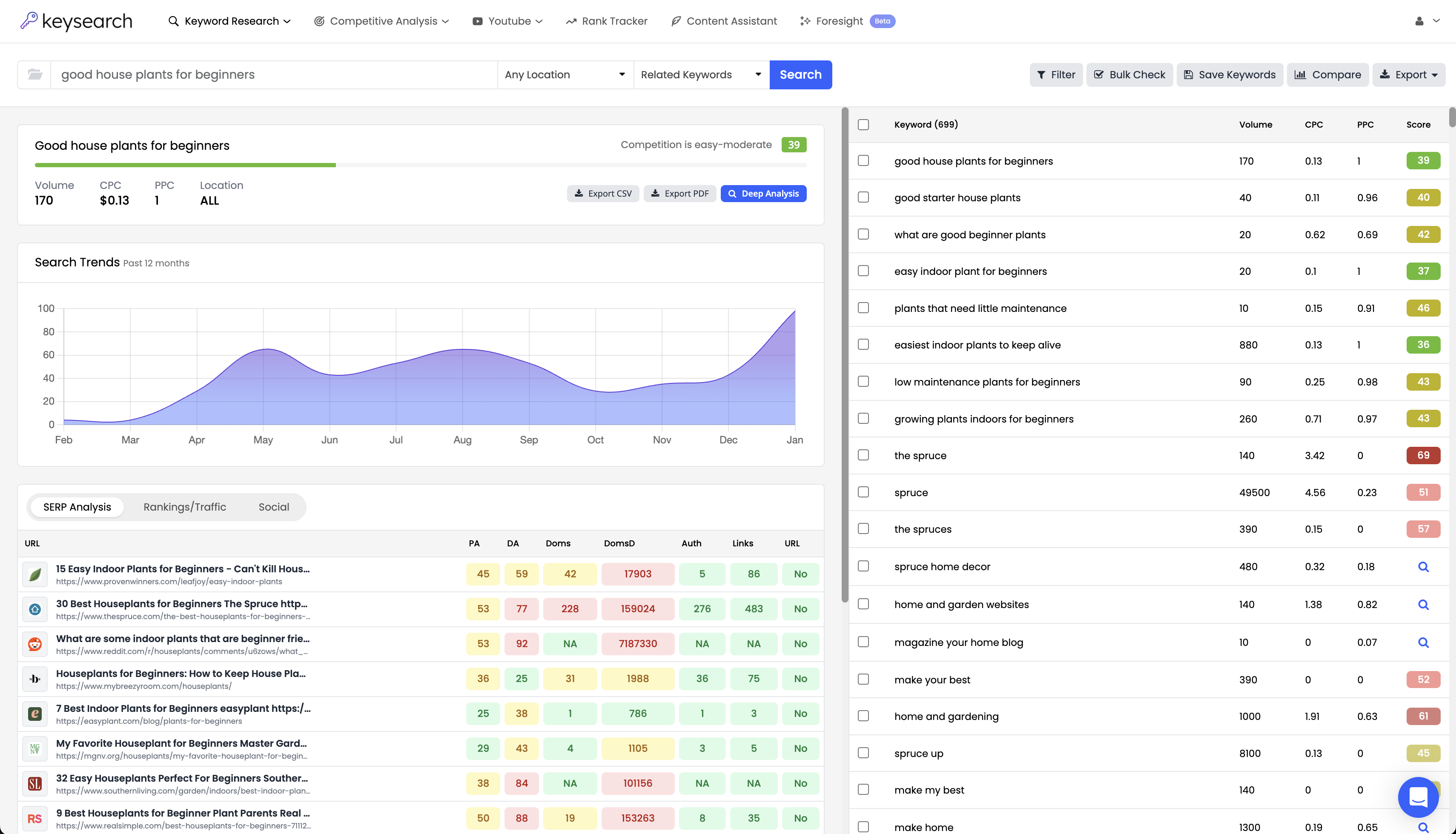The idea of mapping out and implementing an SEO strategy can be overwhelming. There are so many moving pieces – from creating content, optimizing the technical details of your site, building backlinks, and more.
We’re here to simplify perhaps the most important part of the process for you here today with our comprehensive keyword research checklist.
After all, starting your strategy with the wrong keywords is like building a home on a sketchy foundation. The good news is you can effortlessly uncover the most relevant, low-competition keywords for your business with a few simple steps.
It’s as simple as finding a seed keyword or a competitor URL and putting it through our free SEO tools. We’ll deliver thousands of opportunities alongside all necessary insights so you can capitalize. So, get started with KeySearch today and dominate the SERPs with as little work as possible!
Keyword Research Checklist: Step-by-Step Guide to Finding Opportunities and Capitalizing
As complex and time-consuming as it may seem, building an expansive list of keyword opportunities for your business is actually fairly quick and easy. You just need the right blueprint along with the best tools for success. We’re here to provide you both at KeySearch.
Identify Your Goals
You need a clear understanding of what you’re trying to achieve before you even begin conducting keyword research.
- Are you trying to fill out a content calendar for your blog?
- Do you need to optimize product descriptions on your website or on Amazon, eBay, or Pinterest?
- Is your goal to uncover low-competition keywords for a profitable advertising campaign?
- Are you trying to increase the visibility of your YouTube videos?
From there, it’s a matter of figuring out who your target audience is. What are their own goals and desires? What pain points do they have? Where are they located?
Doing all this analysis from the start is like cleaning your windshield before a long road trip so you can have a clear view of the road ahead.
Set specific, quantifiable objectives such as increasing organic traffic by a certain percentage or achieving top rankings for specific keywords. Then, you can start to actually look for keyword opportunities.
Start With Seed Keywords
There are two ways you can begin your keyword research efforts: through a seed keyword or a competitor URL. We’ll walk you through both approaches, but we prefer this one because it offers a more comprehensive view.
This can be a sticking point for some, but just think back to your goals.
- Are you trying to build a content calendar? If so, think about the overarching topic your blog covers – that’s your seed keyword.
- On the other hand, if you’re trying to write a product description, think about what it is you’re selling or the problem it solves – these are both great seed keyword descriptors.
You should start to write down a list of these basic terms, which will typically come from industry knowledge. Then, you can get the real fun started by plugging a seed keyword into a tool like KeySearch.
Use a Tool to Uncover Long-Tail Keywords
Inputting just a single word or phrase into a tool like KeySearch will uncover thousands of relevant, related opportunities – complete with data like search volume, difficulty, trends, and more. We recommend filtering for long-tail keywords specifically.
Long-tail keywords are more specific phrases that are often easier to rank for. They also drive highly targeted traffic to your site, meaning they’ll convert at a higher rate than broader keywords. Here’s how it works:
- Enter your seed keywords into the tool.
- KeySearch will generate a list of long-tail keywords that are related to your seed terms.
- Look at the search volume for each long-tail keyword.
- Assess the level of competition to determine how difficult ranking for these keywords will be.
- Choose keywords that have a good balance of search volume and competition.
- Make sure the long-tail keywords are relevant and attract the right audience.
Analyze Competitors
As we said earlier, you can also start your keyword research checklist by finding a competitor who you suspect is driving a lot of the same traffic you want to capitalize on.
This is not just a great starting point, but also works well for established brands looking to find gaps in their content strategy – keywords your competitor is ranking for that you are not.
Again, our tool streamlines this process to help you dissect your competitors’ keyword strategies in just a few clicks:
- Determine who your main competitors are in your niche.
- Enter your competitors’ URLs into KeySearch. We’ll show you what they’re ranking for along with the data (search volume, competition, etc.).
- Look for keywords that have high search volumes but relatively low competition. Make sure they’re relevant to your business – just because your competitor ranks for them, doesn’t mean you should.
- Compare your keyword list with those of your competitors and see where you can gain a competitive advantage.
Keyword Clustering
Now that you have an expansive list of keywords, you should group them together to make sure you’re not targeting similar keywords on different pages. This is known as keyword clustering.
The idea is that you want to avoid duplicate content and wasted resources. Take these two keywords for instance:
- Keyword tool
- Keyword research tool
While they’re different keywords, the intent is more or less the same. You wouldn’t want to create separate pages targeting these keywords; instead, you’d have one page targeting both. Keyword clustering also ensures you’re not leaving gaps in your content, so you can cover the entire topic for a reader.
Our keyword clustering tool makes this process as quick and easy as possible. It’s entirely free, too – here’s how it works:
- Take a list of up to 1,000 keywords and plug it into the tool.
- The tool will automatically group keywords into relevant clusters based on their similarities.
- Examine the clusters to understand the common themes and subtopics.
- Identify high-priority clusters that align closely with your business goals and target audience interests.
- Plan your content around these keyword clusters.
Another approach to keyword clustering is to use an LSI keyword generator, which will find related keywords to a seed phrase for you.
This is a bit different as certain keywords may not appear related. However, the tool identifies keywords that Google themselves associates with the main keyword in question. It’s a great addition to any keyword research checklist.
Check Keyword Difficulty
It’s easy to look at your top keywords and prioritize them based on search volume. Why would you start with long-tail phrases that only have a few searches a month when you could execute your strategy around keywords that have hundreds of thousands of monthly searches?
You need to be realistic about what you are capable of ranking for.
This is why using a keyword difficulty checker is so important. You won’t waste resources on opportunities that just aren’t feasible for your business based on what’s currently ranking compared to your site’s authority. Here’s how it works:
- Enter your selected keywords into the difficulty checker tool.
- The tool will provide a difficulty score based on factors like competition, current rankings, and domain authority.
- Keywords with lower difficulty scores are generally easier to rank for, especially for newer or smaller websites.
- Choose a mix of low, medium, and high-difficulty keywords to balance quick wins with long-term goals.
- Prioritize keywords that offer the best balance of low difficulty and high search volume.
Now, you can still go back and target high-difficulty keywords after you’ve built your site’s authority up. But in the meantime, it’s best to focus on the low-hanging fruit.
Evaluate Keyword Relevance
Relevancy is everything in SEO. Not only will you fail to see an ROI by ranking for keywords that don’t align with your product or service, but search engines will rarely rank you for these keywords if your site doesn’t have topical relevancy.
There are tools out there that can help you determine the relevancy of your keywords, but ultimately, the best way to assess this is using your instincts and thinking about your business:
- Select keywords that directly relate to your products, services, or content goals.
- Avoid keywords that, despite high traffic, do not align with what you offer.
- Take into account the intent behind each keyword – whether it’s informational, navigational, or transactional.
- Make sure the keywords fit naturally within the context of your content.
Integrate Keywords into Your Strategy
So you’ve walked through our keyword research checklist and have a ton of great keywords that are relevant, feasible, and ready to be implemented into an SEO strategy – now what? Here are your next steps:
- Develop content calendars based on your keyword clusters and prioritized keywords.
- Plan individual pieces of content around specific keywords or clusters.
- Incorporate keywords into titles, headers, meta descriptions, and body text.
- Use variations of the keywords to enhance the natural flow of the content.
- Optimize URLs, image alt texts, and internal links with target keywords.
- Focus on creating high-quality, informative content that provides value to your audience.
- Balance keyword use with readability and user experience to avoid over-optimization.
- Gather backlinks using anchor text that matches your keywords (vary up the anchor text to avoid link spam penalties).
We have a few tools that support content creation, such as our keyword density checker or duplicate content checker. These are great for making sure anything you publish is optimized to rank.
Monitor Rankings and Adjust Over Time
SEO is an ongoing battle, and it can take months to see any traction with your efforts. However, we’ve seen countless examples of sites starting from scratch being able to rank fast by using an effective strategy like the one we’ve described above.
At this point, it’s just a matter of keeping your head down and executing your content calendar, continuing to acquire backlinks, and monitoring rankings to gauge results. Here are some final tips on our checklist for keyword research:
- Use KeySearch’s rank tracking tool to monitor where your content ranks for each keyword.
- Keep an eye on metrics like search volume, click-through rates, and traffic.
- Look for trends in your rankings to identify which keywords are performing well and which are not. Refine your keyword strategy accordingly.
- Pay attention to seasonal variations and algorithm updates that might impact your rankings.
- Revisit pages that are stuck below positions 1-3 after they’ve acquired rankings and look for room for improvement.
Execute This Keyword Research Checklist With KeySearch Today!
There you have it – everything you need to know about conducting keyword research for your blog, e-commerce store, or service-based website. You can even apply these same principles to a YouTube channel!
The only thing left to do at this point is get started with the #1 keyword research tool on the market: KeySearch. Our solution is easier to use than the competition, more affordable, and delivers superior insights.
One affordable subscription unlocks a wealth of tools to support you in planning and executing an SEO strategy – from keyword generators to content analyzers, rank trackers, competition analyzers, niche brainstorming, and much, much more. We even have specific tools for specific use cases, such as:
More than 10,000 people a month use our tools, including the likes of Shopify, Ezoic, Mediavine, Search Engine Journal, and more. With a 4.9 star rating across hundreds of reviews, it’s clear that KeySearch is a valuable asset in your SEO toolkit.
You can get started 100% free today, too. Then once you see what’s possible, you can scale your plan up as needed to make your SEO goals a reality. Still not convinced KeySearch is right for you? See how we stack up to the competition:
It’s time to dominate the SERPs. Follow our keyword research checklist, execute your SEO strategy, and watch the organic traffic flood your way in no time!
- How to Do Keyword Research for Free: Best Free Keyword Research Tools in 2024 - December 13, 2024
- Benefits of Keyword Clustering: Why is it Important to Group Relevant Keywords Together? - December 13, 2024
- What is Keyword Density in SEO and Its Importance - December 13, 2024







